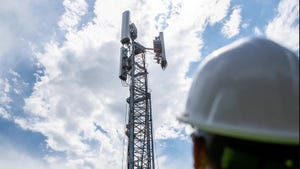Huawei's GTS delivers intelligent digital ICT service and software solutions for its customers
April 28, 2023

Sponsored Content
The growing world of 5G services offers significant business and diversification opportunities for telecom operators.
But it brings new technology and business challenges that operators and their vendor partners need to solve.
This is where Huawei�’s Global Technical Service Department (GTS) plays a role. Its mission is to provide intelligent digital ICT service and software solutions for its customers.
Austin You, President of the Carrier Delivery & Service Dept of the GTS, Huawei, cites as an example the different priorities in 5G enterprise network deployments.
Traditionally the focus was on building out network coverage, but for a private network at an industrial site, “we need to ensure quality network from the outset. We can’t tolerate any machines stopping.”
Critical machinery such as a crane operation in a mine or port had extremely demanding provisioning requirements, very different from B2C, Mr. You said.
“We don’t want interruptions happening or video stream down without any maintenance activity. We need to provide a digital platform to identify network failures quickly and proactively.”

Austin You, President of the Carrier Delivery & Service Dept of the GTS, Huawei
One part of the solution lay in preventative measures in planning, building, optimizing, and maintaining the network, he said.
The other part was providing the highest level of SLAs in this special scenario.
Mr. You said Huawei has forged collaborative relationships with enterprise customers in implementing and deploying 5G to business solutions.
One successful project is with Panzhihua Iron and Steel Company, the largest steel-maker in western China, which has adopted Huawei’s open-pit mine digital solution.
It uses 5G to connect mining equipment in the pit with the central control system of edge data centers. The high bandwidth and low latency allow for unified scheduling and remote mine operations.
Huawei also provisioned an autonomous driving solution to support trucks and remote crane control and a campus management platform that accelerate digital transformations of industries including mining, ports and steel manufacturing.
Another critical challenge is the exacting sustainability requirements for telcos and enterprises.
GTS software and services aid Huawei in ensuring optimal network energy efficiency and customer experience from the deployment of cellsites, data centers and networks.
Ocean Sun, Director of the GTS Marketing Dept, Huawei, said the aim was to find the balance between energy efficiency and customer experience.
“We want to build green sites, to remove air-conditioning from the equipment room and introduce solar power, and simplify operations. Only then we can drive high energy efficiency,” he said.
Huawei’s green and simplified networks help significantly improve network resource utilization through spectrum refarming and network reconstruction.
He said Huawei had deployed many green simplified sites, typically delivering energy savings of around 40%.
Huawei deployed green energy devices such as PV modules and lithium batteries to help Turkish operator Turkcell reduce energy consumption of each basestation site.
By 2022, Huawei had delivered more than 500,000 sites, 100 networks, and 100 data centers, which resulted in saving 400 million kWh of electricity and cutting carbon emissions by 140,000 tons, equivalent to planting 7.5 million trees.
AI is set to play an important role in boosting energy efficiency, according to Echo Liu,Director of the GTS Strategy & Business Development Dept.
Operators can deploy AI solutions to automatically turn down or switch off basestation radios when not required or not being used.
Aside from driving energy efficiency, Huawei is developing innovative AI capabilities — such as a knowledge graph, AR inspection, and prediction and prevention — for early network risk identification and prevention.
It is also applying AI to enhance network management capabilities as telecom networks evolve towards intelligent O&M.
Huawei’s intelligent O&M solution continuously integrates intelligence into O&M processes, accelerating digital transformation while shortening the development cycle and improving human-machine interaction experience.
Huawei’s AUTIN intelligent O&M solution has been applied in more than 150 networks around the world, including Zhejiang and Jiangsu where it has helped China Mobile achieve highly autonomous networks.
The solution accelerates the intelligent digital transformation of network O&M and shortens O&M app development from months to weeks, enabling O&M engineers to quickly implement their ideas.
To ensure responsive and expert service for Huawei customers, GTS has built an intelligent, open ICT service platform that draws on the expertise of more than 20,000 Huawei experts and 6200 partners worldwide who jointly provide tailored professional services.
Huawei provides training and enablement for partners and customers, with more than 5 million trainees, of whom 1 million have received Huawei certifications.
Mr. You said GTS would continue to invest in ICT Service and Software to develop leading solutions, including solutions for green and efficient integration, robust networks, intelligent O&M, intelligent experience optimization, new digital services, and Huawei Intelligent Talent.
“We aim to provide customers with warm and professional services, and work with customers to build an intelligent world with ultimate experience.”
About the Author(s)
You May Also Like











_1.jpg?width=300&auto=webp&quality=80&disable=upscale)


.png?width=800&auto=webp&quality=80&disable=upscale)